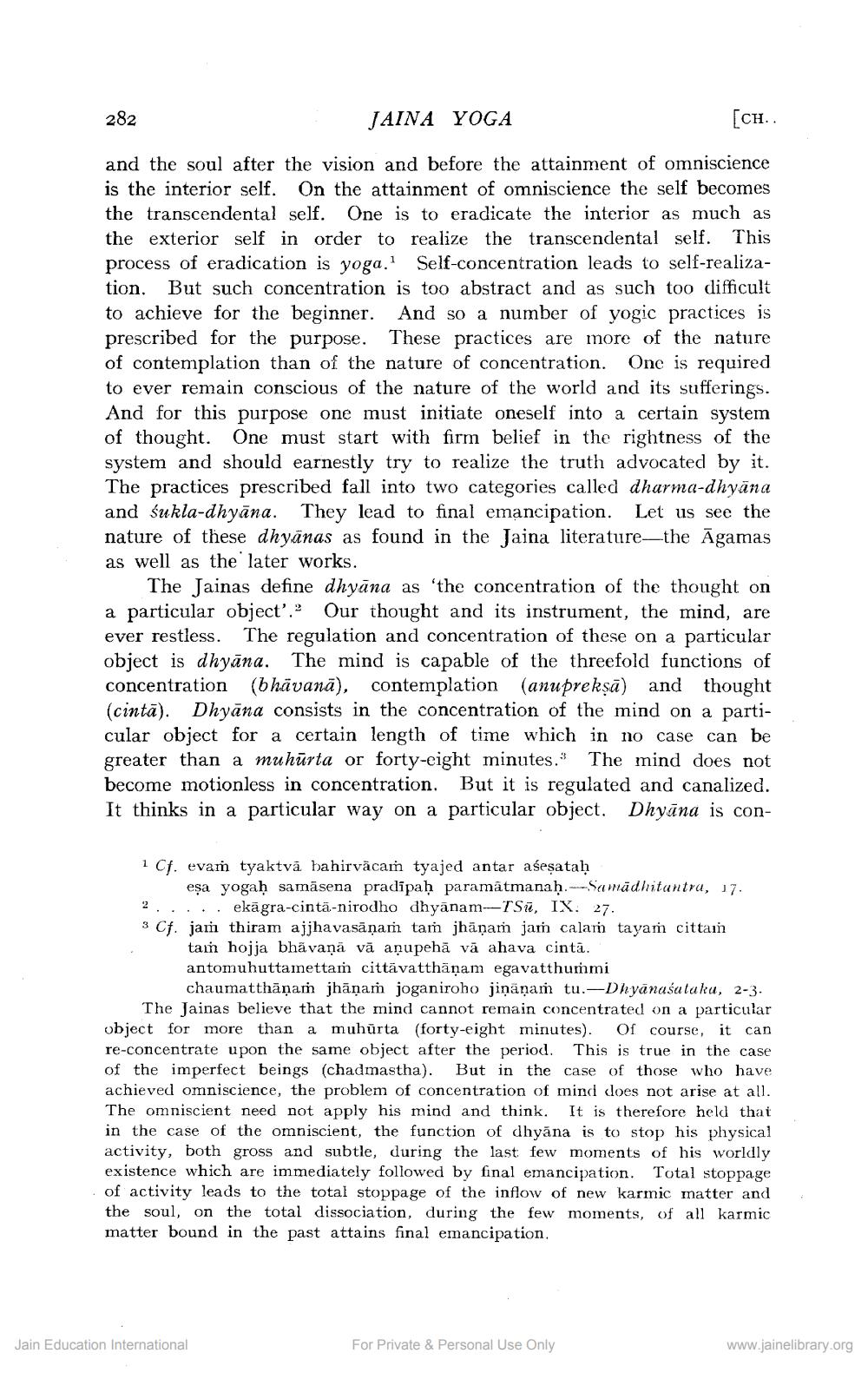________________
282
JAINA YOGA
and the soul after the vision and before the attainment of omniscience is the interior self. On the attainment of omniscience the self becomes the transcendental self. One is to eradicate the interior as much as the exterior self in order to realize the transcendental self. This process of eradication is yoga. Self-concentration leads to self-realization. But such concentration is too abstract and as such too difficult to achieve for the beginner. And so a number of yogic practices is prescribed for the purpose. These practices are more of the nature of contemplation than of the nature of concentration. One is required to ever remain conscious of the nature of the world and its sufferings. And for this purpose one must initiate oneself into a certain system of thought. One must start with firm belief in the rightness of the system and should earnestly try to realize the truth advocated by it. The practices prescribed fall into two categories called dharma-dhyāna and śukla-dhyana. They lead to final emancipation. Let us see the nature of these dhyanas as found in the Jaina literature-the Agamas as well as the later works.
The Jainas define dhyana as 'the concentration of the thought on a particular object'." Our thought and its instrument, the mind, are ever restless. The regulation and concentration of these on a particular object is dhyana. The mind is capable of the threefold functions of concentration (bhāvanā), contemplation (anuprekṣā) and thought (cinta). Dhyana consists in the concentration of the mind on a particular object for a certain length of time which in no case can be greater than a muhurta or forty-eight minutes." The mind does not become motionless in concentration. But it is regulated and canalized. It thinks in a particular way on a particular object. Dhyana is con
[CH..
1 Cf. evam tyaktva bahirvācaṁ tyajed antar aseṣataḥ
eṣa yogaḥ samasena pradipaḥ paramatmanaḥ.-Samadhitantra, 17. ekagra-cinta-nirodho dhyanam-TS, IX. 27.
2
3 Cf. jam thiram ajjhavasāņam tam jhāņam jam calam tayam cittam tam hojja bhavaṇā vā aņupeha va ahava cinta. antomuhuttamettam cittavatthäṇam egavatthummi
chaumatthāṇam jhāņam joganiroho jiņāņam tu.-Dhyanasataka, 2-3The Jainas believe that the mind cannot remain concentrated on a particular object for more than a muhurta (forty-eight minutes). Of course, it can re-concentrate upon the same object after the period. This is true in the case of the imperfect beings (chadmastha). But in the case of those who have achieved omniscience, the problem of concentration of mind does not arise at all. The omniscient need not apply his mind and think. It is therefore held that in the case of the omniscient, the function of dhyana is to stop his physical activity, both gross and subtle, during the last few moments of his worldly existence which are immediately followed by final emancipation. Total stoppage of activity leads to the total stoppage of the inflow of new karmic matter and the soul, on the total dissociation, during the few moments, of all karmic matter bound in the past attains final emancipation.
Jain Education International
For Private & Personal Use Only
www.jainelibrary.org




